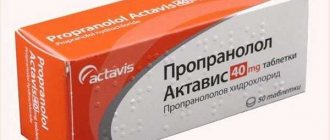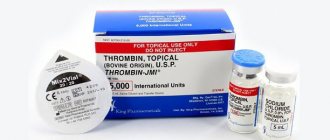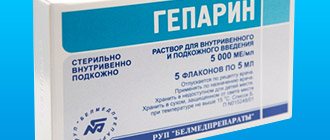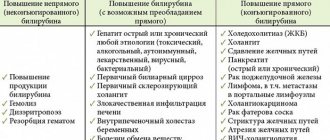CC dossier
Savely Barger (MOSCOW),
cardiologist, candidate of medical sciences. In the 1980s, he was one of the first scientists in the USSR to develop a technique for diagnostic transesophageal cardiac pacing. Author of manuals on cardiology and electrocardiography. He is the author of several popular books devoted to various problems of modern medicine.
It is safe to say that beta-blockers are first-line drugs for the treatment of many diseases of the cardiovascular system.
Here are some clinical examples.
Patient B., 60 years old, suffered an acute myocardial infarction 4 years ago. Currently, he is bothered by characteristic compressive pain behind the sternum during light physical exertion (with a slow pace of walking he can walk no more than 1000 meters without pain). Along with other medications, he receives bisoprolol 5 mg morning and evening.
Patient R., 35 years old. At the appointment, he complains of constant headaches in the occipital region. Blood pressure 180/105 mm Hg. Art. Treatment with bisoprolol is carried out at a daily dosage of 5 mg.
Patient L., 42 years old, complained of interruptions in the work of the heart, a feeling of “fading” of the heart. During daily ECG recording, frequent ventricular extrasystoles and episodes of “jogs” of ventricular tachycardia were diagnosed. Treatment: sotalol 40 mg twice daily.
Patient S., 57 years old, suffers from shortness of breath at rest, attacks of cardiac asthma, decreased performance, and swelling in the lower extremities, which worsens in the evening. Ultrasound examination of the heart revealed diastolic dysfunction of the left ventricle. Therapy: metoprolol 100 mg twice a day.
In such diverse patients: coronary heart disease, hypertension, paroxysmal ventricular tachycardia, heart failure - drug treatment is carried out with drugs of the same class - beta-blockers.
How do adrenaline receptor blockers work?
The mechanism of action of β-blockers is associated with temporary blocking of adrenergic receptors. The drugs limit the effects of adrenal hormones by reducing the sensitivity of target cells. β-adrenergic receptors respond to adrenaline and norepinephrine. They are found in different systems of the body:
- myocardium;
- fatty tissue;
- liver;
- blood vessels;
- kidneys;
- bronchi;
- muscular layer of the uterus.
Taking adrenergic blockers leads to a reversible shutdown of receptors sensitive to catecholamines. These are bioactive substances that provide intercellular interactions in the body. This leads to the following effects:
- expansion of the internal diameter of the bronchi;
- decreased blood pressure;
- expansion (vasodilation) of blood capillaries;
- reducing the severity of arrhythmia;
- increased release of oxygen from blood cells to cells;
- decreased heart rate (HR);
- stimulation of myometrial contractions;
- decreased blood sugar concentration;
- decrease in the speed of impulses to the myocardium;
- increased peristalsis of the gastrointestinal tract;
- slowing down the synthesis of thyroxine by the thyroid gland;
- decreased myocardial oxygen demand;
- acceleration of lipid breakdown in the liver, etc.
Adrenergic blockers acting on beta-adrenergic receptors are used primarily in the treatment of diseases of the cardiovascular, respiratory and digestive systems.
Mechanism of action
BBs reduce the frequency and strength of heart contractions and lower blood pressure. As a result, oxygen consumption by the heart muscle decreases.
Diastole lengthens - a period of rest and relaxation of the heart muscle, during which the coronary vessels are filled with blood. Improvement of coronary perfusion (blood supply to the myocardium) is also facilitated by a decrease in intracardiac diastolic pressure.
There is a redistribution of blood flow from normally blood-supplied areas to ischemic areas, as a result of which physical exercise tolerance improves.
Beta blockers have an antiarrhythmic effect. They suppress the cardiotoxic and arrhythmogenic effects of catecholamines, and also prevent the accumulation of calcium ions in the heart cells, which worsen energy metabolism in the myocardium.
Classification of drugs
β-adrenolytics are a large group of medications that are used in the symptomatic treatment of various diseases. They are conventionally divided into 2 categories:
- Selective beta-1 adrenergic blockers are drugs that block beta 1 adrenergic receptors in the kidneys and myocardium. They increase the resistance of the heart muscle to oxygen starvation and reduce its contractility. With timely administration of adrenergic blockers, the load on the cardiovascular system is reduced, as a result of which the likelihood of death from myocardial insufficiency is reduced. New generation drugs cause virtually no unwanted effects. They eliminate bronchospasms and prevent hypoglycemia. Therefore, they are prescribed to people suffering from chronic bronchial diseases and diabetes.
- Non-selective beta-blockers are drugs that reduce the sensitivity of all types of beta-adrenergic receptors located in the bronchioles, myocardium, liver, and kidneys. Used to prevent arrhythmia, reduce renin synthesis by the kidneys, and improve the rheological properties of blood. Beta-2 blockers prevent the production of fluid in the sclera of the eye, and are therefore recommended for the symptomatic treatment of glaucoma.
The higher the selectivity of adrenergic blockers, the lower the risk of complications. Therefore, the latest generation drugs are much less likely to provoke adverse reactions.
Selective adrenergic blockers inhibit exclusively β1 receptors. They have almost no effect on β2 receptors in the uterus, skeletal muscles, capillaries, and bronchioles. Such drugs are safer, therefore they are used in the treatment of heart diseases with serious concomitant problems.
Classification of drugs depending on solubility in lipids and water:
- Lipophilic (Timolol, Oxprenolol) - soluble in fats, easily overcome tissue barriers. More than 70% of the components of the drug are absorbed in the intestines. Recommended for severe heart failure.
- Hydrophilic (Sotalol, Atenolol) - slightly soluble in lipids, therefore they are absorbed from the intestine by only 30-50%. The breakdown products of adrenergic blockers are excreted primarily by the kidneys, so they are used with caution in cases of renal failure.
- Amphiphilic (Celiprolol, Acebutolol) - easily soluble in fats and water. When taken orally, they are absorbed in the intestines by 55-60%. The drugs are approved for compensated kidney or liver failure.
Some adrenergic blockers have a sympathomimetic effect - the ability to stimulate β-receptors. Other drugs have a moderate dilating effect on the capillaries.
Scroll
1. Non-cardioselective beta blockers:
A. Without internal sympathomimetic activity:
- propranolol (anaprilin, obzidan);
- nadolol (korgard);
- sotalol (sotahexal, tenzol);
- timolol (blocarden);
- nipradilol;
- flestrolol.
B. With internal sympathomimetic activity:
- oxprenolol (Trazicor);
- pindolol (wisken);
- alprenolol (aptin);
- penbutolol (betapressin, levatol);
- bopindolol (Sandorm);
- bucindolol;
- dilevalol;
- carteolol;
- labetalol.
2. Cardioselective beta blockers:
A. Without internal sympathomimetic activity:
- metoprolol (betaloc, betaloc zok, corvitol, metozok, metocard, metocor, serdol, egilok);
- atenolol (betacard, tenormin);
- betaxolol (betak, lokren, kerlon);
- esmolol (breviblok);
- bisoprolol (aritel, bidop, biol, biprol, bisogamma, bisomore, concor, corbis, cordinorm, coronal, nipperten, tirez);
- carvedilol (acridilol, bagodilol, vedicardol, dilatrend, carvedigamma, carvenal, coriol, recardium, tallitone);
- nebivolol (binelol, nebivator, nebikor, nebilan, nebilet, nebilong, nevotenz, od-neb).
B. With internal sympathomimetic activity:
- acebutalol (acecor, sectral);
- talinolol (cordanum);
- celiprolol;
- epanolol (vasacor).
3. Beta blockers with vasodilating properties:
A. Non-cardioselective:
- amozulalol;
- bucindolol;
- dilevalol;
- labetolol;
- medroxalol;
- nipradilol;
- pindolol.
B. Cardioselective:
- carvedilol;
- nebivolol;
- Celiprolol.
4. Long-acting beta blockers:
A. Non-cardioselective:
- bopindolol;
- nadolol;
- penbutolol;
- sotalol.
B. Cardioselective:
- atenolol;
- betaxolol;
- bisoprolol;
- epanolol.
5. Ultra-short-acting beta blockers, cardioselective:
- esmolol.
To whom and when are adrenergic blockers prescribed?
Selective and non-selective β-adrenolytics are recommended for the symptomatic treatment of many diseases. They have a different spectrum of action, so the indications for their use differ.
Indications for the use of non-selective adrenergic blockers:
- tremor;
- hypertension;
- painful palpitations;
- mitral valve prolapse;
- tense angina;
- cholecystocardiac syndrome;
- high intraocular pressure;
- cardiomyopathy;
- prevention of ventricular arrhythmia;
- preventing the risk of recurrent myocardial infarction.
Selective adrenergic blockers act on the myocardium, with almost no effect on the capillaries. Therefore, heart pathologies are treated with such means:
- heart attack;
- paroxysmal arrhythmia;
- coronary heart disease;
- neurocirculatory dystonia;
- atrial tachycardia;
- atrial fibrillation;
- left valve prolapse.
Beta blockers, which have the properties of α-adrenolytics, are used in combination therapy:
- glaucoma;
- myocardial failure;
- hypertension and hypertensive crisis;
- arrhythmias.
Drugs that affect myocardial contractile activity should not be used for self-medication. Irrational therapy is fraught with increased load on the vascular system and cardiac arrest.
The role of beta blockers in cardiologist practice in the light of recent research
Oksana Mikhailovna Drapkina , professor, doctor of medical sciences:
– Professor Alexey Olegovich Shevchenko: “The role of beta blockers in the practice of a cardiologist in the light of recent research.”
Alexey Olegovich Shevchenko , professor, doctor of medical sciences:
– The effect of beta blockers is primarily due to the fact that they prevent the toxic effect of catecholamines. Beta adrenergic receptors are found in most cells and in most tissues of the body. Therefore, in addition to reducing heart rate, improving myocardial filling, antiarrhythmic action, anti-ischemic action, reducing renin levels, there are a number of additional actions, which are sometimes called pleiotropic, and sometimes these are simply new effects that are discovered in connection with the study of the functions and mechanisms of action of beta -adrenoreceptors.
At least clinically, the first place should be given to the use of beta blockers for the purpose of cardioprotection as antiarrhythmic drugs. Of course, they have a powerful anti-ischemic effect and hypotensive effect. And the larger number of patients, of course, in whom beta-blockers actually have a clear and proven effect are patients, first of all, of secondary prevention, but also patients with arterial hypertension.
Of course, the history of beta blockers goes back almost 50 years. 48 years ago, the most successful beta blocker that appeared, before that there were other drugs, but in 1964, in the May edition of The Lancet, an article appeared, “A new adrenergic drug: Propranolol,” which was created in the laboratory of James Black, for which he received the Nobel Prize in 1988.
Over the past few decades, drugs have been used and studied, and of the most controversial issues that exist today, I would highlight two, although there are, of course, more. First: how unique are they? And second: the peculiarity of clinical application in various situations. At least the uniqueness of beta-blockers, of course, primarily concerns their interchangeability, because different molecules are used. We have a fairly large number of “good” beta-blockers, and on the other hand, the same molecules are produced by different manufacturers. In particular, all beta-blockers, due to their beta-blocking action, effectively reduce the risk of death and effectively reduce the risk of recurrent myocardial infarction. On the other hand, studies that have also been around for quite a long time have shown that the more highly selective the drug is, and if it lacks internal sympathomimetic activity, the more effective it is relative to others in reducing the risk of developing undesirable cardiovascular events. To date, we do not use drugs with intrinsic sympathomimetic activity, but in terms of selectivity, they do differ. Selectivity for beta-blockers is a very relative indicator: selectivity may decrease with increasing dose.
We have good non-selective beta blockers that we use. Of course, that same fast and short-acting Propranolol, which appeared very first, which has not left us anywhere. Sotalol, which has good antiarrhythmic activity, including the properties of a class III antiarrhythmic. Carvedilol is an excellent drug, an alpha1, beta1, beta2 antagonist, which also has a proven effect in patients with heart failure.
Medications of moderate selectivity. What does “moderate selectivity” mean? In small doses, there are practically no side effects associated with blocking beta2 receptors, but with increasing doses this effect is noticeable, and has been shown in many studies. Moderate selectivity includes hydrophilic Atenolol and lipophilic Metoprolol.
The most highly cardioselective drugs. Today, the ones we have are, of course, Nebivolol and Bisoprolol. Which of them is more cardioselective is actually a very controversial question. They both turned out to be more cardioselective relative to other beta-blockers. But when they tried to compare them with each other, it turned out that the results were contradictory. As an example, one study done in 2002 showed that Nebivolol was four times more cardioselective than Bisoprolol. Under the same conditions, a study was conducted in another laboratory - and they saw that, on the contrary, Bisoprolol turned out to be several times more cardioselective than Bisoprolol. It’s probably difficult to answer here - different studies really gave different data. But there is probably no question that they have greater cardioselectivity than others.
And the second question is small, but nevertheless takes a lot of time - this, of course, is the question of the interchangeability of products produced at different factories by different manufacturers. We live in a difficult time when we have non-medical terms associated with rebranding, franchising, globalization, when even one drug, which was originally produced by one company, is transferred to another company, then a third one appears, then so-called generics appear. And here it is necessary not only to prove that the drug has the same bioequivalence: it is excreted at the same rate, distributed in the same quantities in the blood, but also, probably, clinical evidence.
As an example: literally at the beginning of this year, the work of Professor Protasov and co-authors was published, who studied the effectiveness of Bidop - this is Bisoprolol produced and the drug Concor - this is Bisoprolol, which appeared first. In a crossover study in patients, it was found that the practically hypotensive effect of Bidop is no different from Bisoprolol, which was the first to appear, from Concor. Similarly, we conducted the same small crossover study, already trying to evaluate anti-ischemic activity. And they saw that Bidop did not differ from Concor in terms of its effect on the duration of physical activity and the number of attacks. And there are quite a large number of similar studies; they showed that Bisoprolol produced by Gedeon Richter was no different from the same Concor that appeared first.
Several months ago, we demonstrated, including here, the results of our research on the prescription of cardiovascular drugs to patients with psoriasis. And in the same way, Bisoprolol produced by both one and another company, being a highly cardioselective drug, not only did not lead to an increase in side effects of therapy, but was also accompanied by a significant improvement in the clinical status of patients.
The second question is, of course, the features of the clinical use of beta-blockers. Probably, beta-blockers for arterial hypertension have raised the most questions over the past few years. The reason is as follows. On the one hand, indeed, they have a huge number of mechanisms with which the hypotensive effect is associated, and they have a hypotensive effect. In addition to reducing the bioavailability of catecholamines, they have quite effective, including antirenin, effects. There is now debate about the role of renin itself as a central molecule in arterial hypertension, but nevertheless, beta-adrenergic receptors, especially beta-1 adrenergic receptors, are very strongly represented in the juxtaglomerular apparatus. And according to many studies, beta blockers - in particular, the results with Atenolol and Bisoprolol are presented here - are just as effective in reducing plasma renin activity as a superselective renin receptor blocker. And it has even been shown that a single dose of one tablet of Bisoprolol 10 milligrams leads to a decrease in plasma renin activity by 65%, and this effect lasts for almost a week.
On the other hand, what causes this very paradox? Because several years ago a number of meta-analyses were presented, which showed: when beta-blockers were prescribed at the stage of primary prevention, that is, in patients who had not suffered a myocardial infarction, then for some reason they developed symptoms after some time. Especially, unfortunately, in women, mortality from all causes, mortality from cardiovascular diseases, heart attacks, and strokes increased. Of course, we can say that meta-analyses have some negative sides, although they probably have much more positive sides. But what were the assumptions and theories? At first, everyone “pointed the finger” at Atenolol, although in fact some people think that maybe in vain, because Atenolol is an amazing drug that is still used in many countries around the world. Yes, it's cheap, yes, it's not that new, yes, it's not that fashionable. But maybe he was prescribed incorrectly? In those studies where he lost, where he showed perhaps insufficient activity, he was prescribed once and in fairly high doses: 50 or 100 milligrams. If we were to prescribe it twice a day, in the morning and in the evening, even though we now have a fairly large number of long-acting drugs for a single dose, Atenolol still did not overlap the day. Of course, a negative metabolic effect could also have had an impact. Beta-blocker drugs, especially non-selective and moderate cardioselective ones, have a more pronounced negative effect on both lipid metabolism and carbohydrate metabolism.
Another interesting idea, which was presented in several works, both physiological and clinical, is the so-called idea of pulse wave desynchronization, the meaning of which is that if artificially in patients who have not suffered a myocardial infarction and without pronounced remodulation of the arterial wall to slow down the rhythm with medication, this actually leads to the fact that the return wave arrives at the aortic valves not in diastole as expected, but in systole or in some other phases. In this case, there is a collision of two waves, ascending and reflected, and the result is what we saw in the ASCOT-CAFE study, when, against the background of the calcium antagonist Amlodipine, the pressure in the aorta was lower than against the background of taking the same Atonalol. But these issues, of course, need to be discussed, although again I want to remind you that the latest recommendations, which have most absorbed the latest clinical experience (the most successful, it seems to me, are the British recommendations and the Canadian recommendations of 2011), show that, despite the fact that beta-blockers, although not first-line treatments, especially in young people, they can be prescribed, especially to those patients who cannot tolerate ACE inhibitors or angiotensin receptor blockers. Remember that in women of childbearing age, inhibitors or blockers have a teratogenic effect starting in the second trimester of pregnancy. This also includes the category of patients in whom sympathetic tone plays a fairly large role in the pathogenesis of arterial hypertension.
In combination therapy for arterial hypertension, drugs containing ACE inhibitors or blockers with calcium antagonists come first. If they don’t work, then many recommendations indicate that a beta blocker is not with a diuretic, but with a dihydroperidine calcium antagonist such as Amlodipine.
As for coronary heart disease, here their effect is most proven, and probably causes less controversy. They actually improve survival and reduce the risk of recurrent myocardial infarction. The COURAGE study showed that adequate drug therapy is as effective in patients with stable angina as the same therapy with stent implantation, that is, stent implantation only led to an improvement in quality of life.
The number one component of this adequate drug therapy, of course, was a beta blocker, to which other drugs were then added if necessary.
Of course, if the patient has suffered a myocardial infarction, then we can not prescribe beta-blockers only when this is associated with some pronounced side effects or some obvious, outright contraindications. At least, it has been shown that selective beta-blockers, even in patients with chronic obstructive pulmonary disease, it is clear that without acute bronchospasm, significantly improve the prognosis after myocardial infarction.
Similarly, in patients with diabetes mellitus who have suffered a myocardial infarction, beta-blockers have a positive effect, which, even in numerical terms, is more pronounced than in patients without diabetes mellitus. The reason is that a patient who has had a myocardial infarction with diabetes has a higher risk than a patient who has had a myocardial infarction but without diabetes. And beta blockers reduce this risk. Of course, the use of cardioselective drugs is indicated here, which have less of an effect on glucose levels and, perhaps, on lipid levels. Although, remember, ten years ago there was an amazing work, it was small, but it assessed the effect of Bisoprolol and Capoten (Captopril) as an ACE inhibitor on insulin receptors. There they studied phosphorylation, there was a surrogate end point. But interestingly, while Captopril, an ACE inhibitor, increased the sensitivity of insulin receptors in patients with diabetes and metabolic syndrome, Bisoprolol did not worsen their affinity, but it increased their maximum activity. That is, when the receptor was activated, its activity was more powerful than in patients who did not receive Bisoprolol. And neither one nor the other affected sensitivity or receptor affinity.
And of course, beta blockers have a proven effect in patients with chronic heart failure, because in the pathogenesis, especially of heart failure with reduced ejection fraction, activation of the renin-angiotensin system, the sympathetic one, has an important pathogenetic significance.
All recommendations, both domestic and European or American, show that beta-blockers, especially in patients with reduced ejection fraction, are an important and integral component of treatment, allowing to improve their long-term prognosis. To date, Bisoprolol, Carvedilol and Metoprolol have proven effects. Previously, Nebivolol was included in domestic and European recommendations, but after some time it was abandoned, because Nebivolol only reduced the frequency of hospitalizations in older people. Well, in the conditions of a clinical study, the frequency of hospitalizations was regarded simply as a factor, perhaps not quite adequately reflecting the activity of the drug.
Beta blocker dosage: Dosage as in clinical studies. The maximum dose for Bisoprolol is 10 milligrams, for Metoprolol – 100 milligrams, for Carvedilol – 25 milligrams.
The peculiarity of dose titration is where a problem arises, because at the same faculty of advanced training for doctors, when we analyze it, many doctors either forget or they do not have the opportunity to titrate. In particular, an example of the CIBIS study with Bisoprolol, where the effectiveness of Bisoprolol was proven. The first two weeks the dose was 1.25 milligrams, after a week another 1.25 milligrams were added, after another week another 1.25 milligrams - this is essentially a homeopathic addition of the dose. Four weeks later - a dose of 5 milligrams, which was waited and watched for side effects. Then another 2.5 milligrams was added - we waited another two and a half weeks. And only then, after four weeks, they brought it up to a dose of 10 milligrams. In general, the maximum dose was reached over three months. How is this possible in our healthcare environment if the patient is not a relative or friend? This, of course, is quite complicated, but this is exactly the scheme that works. Yes, some patients did not have the opportunity to reach a high dose. Someone settled on a small dose: 1.25 or 2.5 milligrams. Some had an average dose of about 5 milligrams. Someone had a high dose. But here’s what’s interesting: no matter what dose we stopped at, the most important thing is that this dose was maximally tolerated - the effect of Bisoprolol was actually observed. And the latest European recommendations say so: it is better for the patient to take at least a little beta-blocker than no beta-blocker at all.
There is another question that is often asked: what if, instead of those three recommended, we use what we have? There is a lot of work here, but I would like to quote Fail Taipovich as one of the most respected colleagues in our country. What they did was simple: when a patient came to them with heart failure on another beta blocker, they replaced it with Bisoprolol. And we saw after some observation time (in my opinion, the hospitalization was two weeks) that the quality of life, clinical status and other indicators significantly improved, despite the fact that blood pressure and heart rate were the same.
And, of course, a huge number of questions related to what and where to start treatment in patients with heart failure. In particular, in the CIBIS study, despite the fact that it is now said that it is necessary to start with ACE inhibitors, it turned out that the prescription still needs to be started with Enalapril or Bisoprolol.
The same three beta blockers recommended for heart failure were compared. Their effect was exactly the same, although the differences in the side effects that were noted were primarily associated solely with their cardioselectivity. And with other truly positive qualities, if the patient had impaired pulmonary function, then, of course, Bisoprolol beat Metoprolol and Carvedilol as the most cardioselective.
In older people with atrial fibrillation, when there was no atrial fibrillation, Bisoprolol and Carvedilol were exactly the same. When there was atrial fibrillation, Bisoprolol was still slightly superior to Carvedilol. Similarly, in the CIBIS ELD studies in older people with heart failure, with other absolutely identical positive effects, the number of side effects with the more cardioselective Bisoprolol still turned out to be slightly less.
Other uses of beta blockers. In the 2009 recommendations, it was shown that in patients undergoing surgery, especially high-risk patients, that is, patients with heart failure, coronary heart disease, diabetes mellitus on insulin therapy, and high creatinine, the addition of beta-blockers also leads to to reduce the so-called operational risk. Quote from those recommendations: “The modern concept of cardioprotection has led to the recommended use of beta-blockers without intrinsic sympathomimetic activity with a long half-life.” In particular, the example of Bisoprolol is given. New data from 2012, primarily experimental (pulmonary hypertension in the experiment), say that, in particular, Bisoprolol slows the progression of right ventricular failure.
Some applications. In particular, we have sometimes recommended Bisoprolol for about ten years to women with migraine attacks. And probably, let’s say, the last aspect is already completely unproven. Some time ago I was in one city, and I saw our fellow doctors, who were in a state of very high, severe nervous tension in connection with their upcoming work, have a non-alcoholic mojito with Bisoprolol on their table. But, as one of our colleagues said, this is already “expressionist medicine”, unproven.
Features and rules of admission
If your cardiologist prescribes adrenergic blockers, you should tell him or her about your regular use of prescription and over-the-counter medications. It is necessary to notify a specialist about serious concomitant pathologies - emphysema, sinus rhythm disorder, bronchial asthma.
To avoid adverse reactions and complications, adrenergic blockers are used in accordance with the instructions:
- tablets are taken after meals;
- During therapy, monitor heart rate;
- if your health worsens, consult a doctor;
- therapy is not stopped without the recommendation of a specialist.
The dosage and duration of treatment depend on the type of disease and are determined by the doctor. You cannot combine adrenergic blockers with other drugs or alcohol. Violation of the rules for the use of β-adrenolytics is fraught with worsening health conditions.
Withdrawal syndrome
If beta blockers are used for a long time in high dosages, then sudden cessation of treatment can provoke the so-called withdrawal syndrome. It is manifested by an increase in angina attacks, the occurrence of ventricular arrhythmias, and the development of myocardial infarction. In milder cases, withdrawal syndrome is accompanied by tachycardia and increased blood pressure. Withdrawal syndrome usually manifests itself a few days after stopping the use of beta blockers.
To avoid the development of withdrawal syndrome, you must follow the following rules:
- discontinue beta blockers slowly, over two weeks, gradually reducing the dosage per dose;
- during and after discontinuation of beta blockers, it is necessary to limit physical activity and, if necessary, increase the dosage of nitrates and other antianginal drugs, as well as medications that lower blood pressure.
How do blockers interact with other drugs?
When treating several groups of drugs at once, the doctor takes into account their selectivity, ability to enhance or weaken the effect of other medications. If necessary, beta blockers are combined with the following drugs:
- Nitrates. The vasodilatory effect on the capillaries is enhanced, bradycardia is leveled by tachycardia.
- Alpha blockers. Medicines mutually enhance each other's effects. This leads to a more powerful hypotensive effect and a decrease in peripheral vascular resistance.
- Diuretics. Adrenergic blockers prevent the release of renin from the kidneys. Because of this, the period of action of diuretics increases.
It is strictly forbidden to combine adrenergic blockers with calcium antagonists.
This is dangerous due to cardiac complications - a decrease in heart rate and the strength of myocardial contractions. Without a doctor's recommendation, beta blockers should not be combined with the following medications:
- Cardiac glycosides. The risk of bradyarrhythmia and decreased myocardial contractions increases.
- Antihistamines. The antiallergic effect is weakened.
- Sympatholytics. The sympathetic effect on the heart muscle decreases, which is fraught with cardiac complications.
- MAO inhibitors. The risk of excessive increases in blood pressure and hypertensive crisis increases.
- Antidiabetic agents. The hypoglycemic effect increases several times.
- Indirect coagulants. The antithrombotic activity of drugs decreases.
- Salicylates. Adrenolytics reduce their anti-inflammatory activity.
Any combination of adrenergic blockers with other antiarrhythmic drugs is potentially dangerous. Therefore, before changing the treatment regimen, be sure to consult a cardiologist.
History of discovery
The first drug of the group was synthesized in 1962. It was prothenalol, which was found to cause cancer in experiments on mice, so it did not receive clinical approval. The debut beta blocker approved for practical use was propranolol (1968). For the development of this drug and the study of beta receptors, its creator, James Black, later received the Nobel Prize.
From the time of the creation of propranolol to the present day, scientists have developed more than 100 representatives of beta blockers, about 30 of which began to be used by doctors in everyday practice. A real breakthrough was the synthesis of a representative of the latest generation of nebivolol. It differed from its relatives in its ability to relax blood vessels, optimal tolerability, and convenient regimen of administration.
Undesirable consequences
Adrenolytic drugs have an irritating effect on the gastrointestinal mucosa. That is why they should be taken during or after meals. Overdose and long-term use of β-blockers negatively affects the functioning of the genitourinary, digestive, respiratory and endocrine systems. Therefore, it is extremely important to follow the dosage prescribed by your doctor.
Possible side effects:
- hyperglycemia;
- angina attack;
- bronchospasms;
- decreased libido;
- decreased renal blood flow;
- depression;
- emotional lability;
- violation of taste perception;
- bradycardia;
- abdominal pain;
- decreased visual acuity;
- attacks of suffocation;
- bowel disorders;
- sleep disturbance.
Insulin-dependent patients should be aware of the increased risk of hypoglycemic coma when taking antidiabetic drugs and adrenergic agents simultaneously.
Side effects
There are a lot of adverse events. But they do not always manifest themselves and are far from equal. Some drugs are easier to tolerate, others are much more difficult.
Among the generalized list are the following violations:
- Dry eyes.
- Weakness
- Drowsiness.
- Headache.
- Decreased orientation in space.
- Tremor, trembling of limbs.
- Bronchospasm.
- Dyspeptic phenomena. Belching, heartburn, loose stools, nausea, vomiting.
- Hyperhidrosis. Increased sweating.
- Skin itching, rash, urticaria.
- Bradycardia, drop in blood pressure, heart failure and other cardiac events that are potentially life-threatening.
- There are side effects from laboratory blood parameters, but it is impossible to detect them on your own.
The list of beta-blocker drugs includes dozens of names; the fundamental difference between them is not always noticeable.
In any case, consultation with a cardiologist is necessary to select an appropriate therapeutic course. You can do harm yourself and only make it worse.
Contraindications
β1- and β2-adrenolytics have similar contraindications for use. Drugs are not prescribed for:
- atrioventricular block;
- bradycardia;
- orthostatic hypotension;
- sinoatrial block;
- left ventricular failure;
- terminal cirrhosis of the liver;
- obstructive pulmonary disease;
- decompensated kidney failure;
- chronic pathologies of the bronchi;
- vasospastic angina;
- acute myocardial failure.
Selective adrenergic blockers are not taken in case of peripheral circulation disorders, pregnancy and lactation.
Use against the background of angina pectoris
In many cases, such medications are among the leading ones for treating angina pectoris and preventing attacks. Unlike nitrates, such drugs do not cause drug resistance during long-term use. Beta-blocker drugs can accumulate in the body, which makes it possible to reduce the dosage of the drug after some time.
Begin therapy with a small dosage, which is gradually increased until it is effective. The dose is selected so that the resting heart rate is at least fifty per minute, and the systolic pressure level is at least one hundred millimeters of mercury. Once the therapeutic effect is achieved, angina attacks stop and exercise tolerance improves. Against the background of progress, the dosage should be reduced to the minimum effective.
Long-term use of high doses of such drugs is considered inappropriate, as this increases the risk of adverse reactions. In case of insufficient effectiveness, it is better to combine these medications with other groups of medications. Such drugs should not be abruptly discontinued, as withdrawal syndrome may occur. Beta blockers are especially indicated if angina is combined with sinus tachycardia, glaucoma, arterial hypertension or constipation.
The newest beta blockers are effective for myocardial infarction.
Metabolic reaction
Non-selective beta blockers can suppress insulin production. Also, these drugs significantly inhibit the processes of glucose mobilization from the liver, which contributes to the development of prolonged hypoglycemia in patients with diabetes. Hypoglycemia, as a rule, promotes the release of adrenaline into the blood, which acts on alpha-adrenergic receptors.
Many blockers, especially non-selective ones, reduce the level of normal cholesterol in the blood and, accordingly, increase the level of bad cholesterol. True, such drugs as Carvedilol, along with Labetolol, Pindolol, Dilevalol and Celiprolol, do not have this drawback.
Nervous system response
Propranolol, along with Metoprolol and other lipophilic biologically active substances, can penetrate into brain cells through the blood-brain barrier. In this regard, they can cause headaches, sleep disturbances, dizziness, memory impairment, and depression. In severe cases, hallucinations, seizures, or coma may occur. These side reactions are much less pronounced with hydrophilic drugs, in particular with Atenolol.
Treatment with beta blockers is sometimes accompanied by disturbances in nerve conduction. This leads to muscle weakness, rapid fatigue and decreased endurance.
Treatment for heart attack
Early use of beta blockers against the background of a heart attack helps limit necrosis of the heart muscle. This significantly reduces mortality and the risk of recurrent heart attack. In addition, the risk of cardiac arrest is reduced.
A similar effect occurs with drugs without sympathomimetic activity; it is preferable to use cardioselective drugs. They are especially useful when a heart attack is combined with such ailments as arterial hypertension, sinus tachycardia, post-infarction angina and tachysystolic atrial fibrillation.
These medications can be prescribed to patients immediately upon admission to the hospital, provided there are no contraindications. If there are no side effects, treatment should continue for at least a year after the heart attack.










